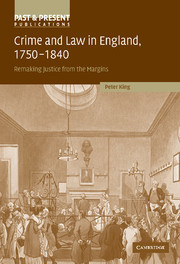Book contents
- Frontmatter
- Contents
- Preface
- List of figures
- List of tables
- 1 Shaping and remaking justice from the margins. The courts, the law and patterns of lawbreaking 1750–1840
- Part I Juveniles
- 2 The rise of juvenile delinquency in England 1780–1840: changing patterns of perception and prosecution
- 3 The punishment of juvenile offenders in the English courts 1780–1830. Changing attitudes and policies
- 4 The making of the reformatory. The development of informal reformatory sentences for juvenile offenders 1780–1830
- Part II Gender
- Part III Non-lethal violence
- Part IV The attack on customary rights
- Index
- Past and Present Publications
2 - The rise of juvenile delinquency in England 1780–1840: changing patterns of perception and prosecution
Published online by Cambridge University Press: 25 July 2009
- Frontmatter
- Contents
- Preface
- List of figures
- List of tables
- 1 Shaping and remaking justice from the margins. The courts, the law and patterns of lawbreaking 1750–1840
- Part I Juveniles
- 2 The rise of juvenile delinquency in England 1780–1840: changing patterns of perception and prosecution
- 3 The punishment of juvenile offenders in the English courts 1780–1830. Changing attitudes and policies
- 4 The making of the reformatory. The development of informal reformatory sentences for juvenile offenders 1780–1830
- Part II Gender
- Part III Non-lethal violence
- Part IV The attack on customary rights
- Index
- Past and Present Publications
Summary
This article focuses on a neglected but historically important transition, the rise to prominence of ‘the problem of juvenile delinquency’ between the 1780s and the 1830s. In the eighteenth century juveniles were rarely indicted in the courts and contemporaries did not usually regard them as a separate or particularly threatening problem. By the mid-nineteenth century juvenile delinquency was established as a major focus of anxiety among the propertied, and separate penal policies and trial procedures for young offenders were being introduced for the first time. Although major works have been written on juvenile delinquency in the later nineteenth and early twentieth centuries, and on the problematic relationship between youth and authority in the sixteenth and seventeenth centuries, historians have been slow to analyse the major transformations that occurred in the intervening period. Overviews of changing penal policies towards the young have been written, and recurring cycles of fear about youthful hooligans have been traced back to the early nineteenth century. However, the relationship between the rise of juvenile crime and other contemporary changes, such as the onset of industrialisation and rapid urbanisation, the reform of many aspects of the criminal justice system or the broader rise of a more disciplinary social agenda, has not been subjected to detailed scrutiny. The period before the 1830s has been particularly neglected.
- Type
- Chapter
- Information
- Crime and Law in England, 1750–1840Remaking Justice from the Margins, pp. 73 - 113Publisher: Cambridge University PressPrint publication year: 2006

